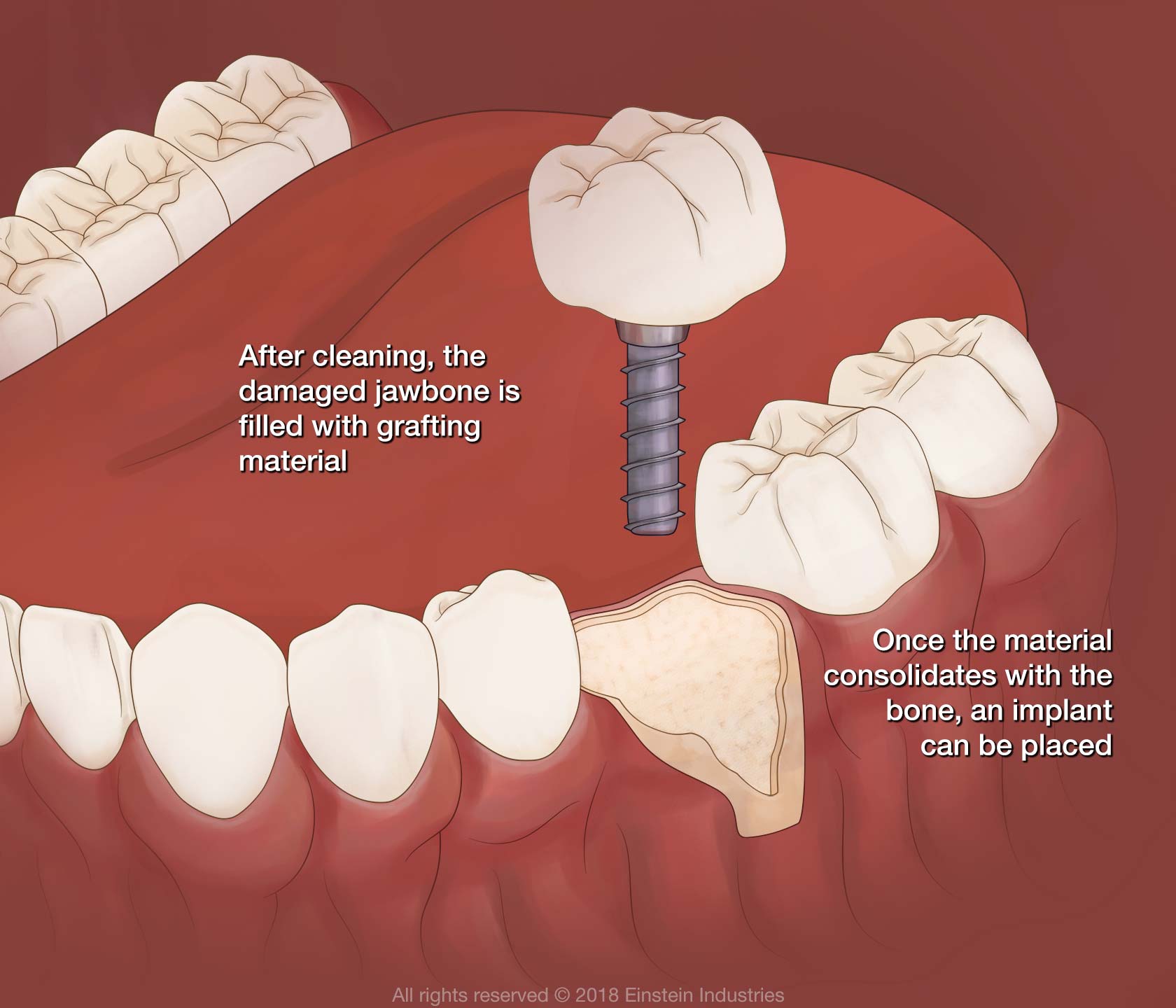
Bone Grafting
Facial trauma, untreated gum disease, and tooth loss can result in jawbone recession, making it difficult to qualify for dental implants.
Bone grafting is a procedure designed to add volume and density to the jawbone and reestablish your candidacy for implant placement.
Let's take a closer look at how bone grafting works...

Grafted Bone Can Function Like Natural Bone Tissue
Help Replace Missing Teeth
Using a biocompatible grafting material or tissue from another part of your body, bone grafting can create a stable foundation for dental implants, allowing you to repair your smile.
Protect Your Smile after an Extraction
After removing a tooth, the jawbone can deteriorate. By packing the tooth socket with grafting material, a bone graft can prevent tissue loss.
High Success Rate
Studies have shown that dental implants placed in grafted tissue have similar success rates to implants placed in natural bone.
Bone grafting replaces deficient jawbone areas with healthy bone tissue, creating a stable foundation for your new dental implants.
Everyone Should Have Access to Dental Implants

*According to ORAL & Implantology.
Dental implants placed in grafted bone tissue have shown outstanding success rates, similar to those of implants placed in natural bone.
Bone Grafts Are Most Commonly Used to Restore Candidacy for Implants
One of the roles of tooth roots is to stimulate the jaw, which signals that nutrients are needed in the area. When you lose a tooth, your brain reroutes essential nutrients away from that area of the jaw.
The longer a tooth is missing, the more likely it is that the jaw will begin to atrophy. Over time, this tissue loss can affect the stability of other teeth, cause further tooth loss, and give your face a sunken, aged appearance.
After a certain point, the jaw loses so much tissue that placing implants is no longer an option without first performing a dental bone graft.
Candidates for a Graft Are in Good Oral and Overall Health
Jawbone Tissue Loss
There are several types of dental bone grafts which address different degrees of bone loss. The area where you have experienced atrophy and the amount of tissue you need to replace will determine which graft you are a candidate for.
Good Dental Health
In general, it is a good idea to address other oral health issues, such as gum disease, before undergoing a grafting procedure.
Stable Overall Health
Medical concerns, such as autoimmune disorders, may limit your ability to heal after surgery and can interfere with your candidacy for a graft.
Modern Techniques Make Bone Grafting Relatively Painless
Thanks to careful planning and minimally invasive techniques, bone grafting is predictable and results in minimal discomfort. In addition to local anesthetic, which numbs the treatment area, your dentist may be able to provide sedation. Options such as nitrous oxide, oral medication, and intravenous sedation are safe and reliable.
Advanced Techniques Can Speed the Healing Process
More and more doctors are integrating platelet-rich fibrin (PRF) and platelet-rich plasma (PRP) into their grafting procedures. Your doctor can create PRF and PRP by separating healing factors from your blood by spinning it in a device called a centrifuge. Then they can apply PRP or PRF to your surgical site and speed up the healing process.

While the Procedure Varies, a Typical Graft Involves Several Steps
The exact nature of your grafting procedure will depend on the type of graft you need. For example, sinus lifts are more complicated than a simple ridge augmentation procedure. However, there are several common steps which typically occur during a dental bone graft.
Thanks to careful planning and minimally invasive techniques, bone grafting is predictable and results in minimal discomfort.
Discomfort and Swelling Is Common, But Shouldn't Last Long
You may experience some discomfort after your bone grafting procedure. You can manage pain using over-the-counter or prescription medications. Swelling and bruising are normal side effects for the first few days.
During the healing process, you should:
- Avoid salty, crunchy, and spicy foods
- Stick with a soft diet for at least the first 24 hours
- Follow all of your doctor's instructions
- Take medication as prescribed
You can reduce swelling during recovery by keeping your head elevated and using icepacks or warm heat. Most doctors recommend getting a lot of rest for the first three days.


It Takes at Least Three Months for a Graft to Stabilize Completely
For most patients, it takes three to six months for the grafted tissue to fuse with the jawbone. For sinus lifts, the recovery period is typically longer, taking about six to nine months.
Once your graft has integrated with your jawbone, you should experience increased stability. If you need implants, your doctor can schedule an appointment to place them as soon as your graft has healed completely.
Your Body Uses Grafted Tissue as a Scaffold to Rebuild Itself
"Bone grafting is possible because bone tissue has the ability to regenerate completely if provided the space into which it has to grow. As natural bone grows, it generally replaces the graft material completely, resulting in a fully integrated region of new bone."
The Journal of Pharmacy & Bioallied Sciences
Some Patients May Choose an Alternative Type of Implant
If you want to enjoy the benefits of dental implants without undergoing bone grafting, ask your dentist if they offer All-on-4® or mini implants. These treatments often do not require preparatory procedures such as bone grafting.
Schedule a Consultation Today
Bone grafting is simple, predictable, and boasts high success rates. Your dentist can help you determine whether a dental bone graft is right for you. Make an appointment today to find out more about this procedure.













